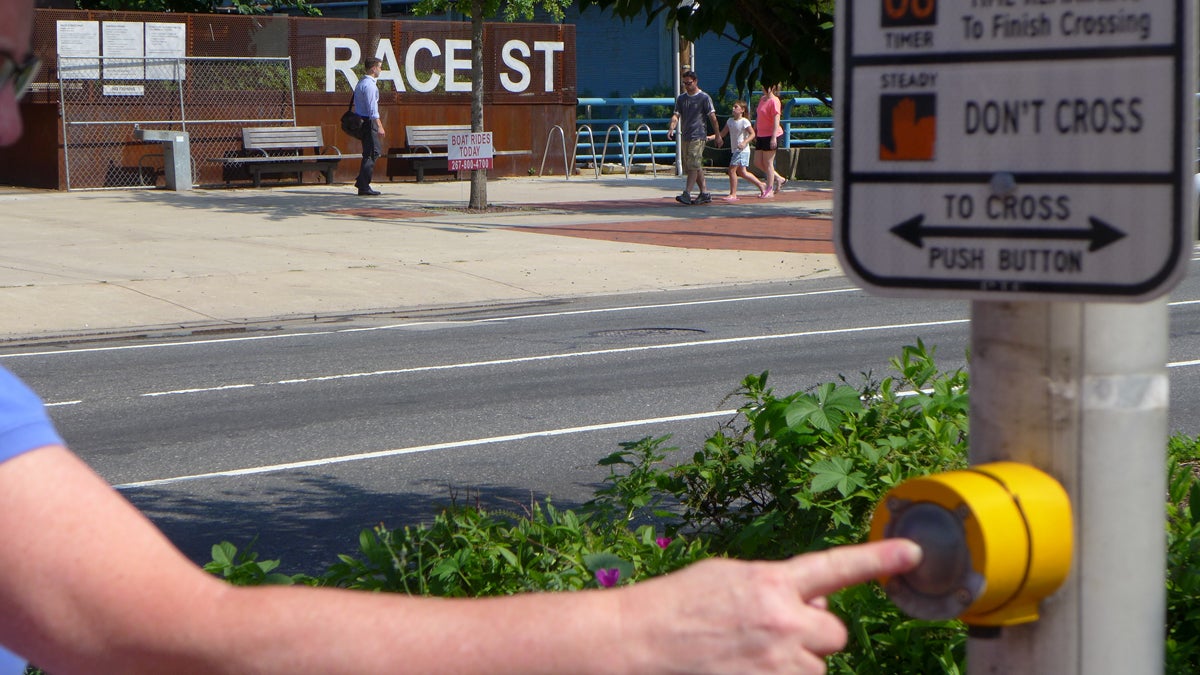Crosswalk button effect: bad design encouraging bad behavior
I gave the large, prominent, silver button a push, and waited for the light to change. I waited some more, then I gave it another push. Nothing seemed to be happening.

The only effect the button at the Race Street/Columbus Boulevard crosswalk seems to have is to frustrate pedestrians and encourage them to cross unsafely. (Image courtesy of Steve Perzan)
Speak Easy is examining issues of street use in Philadelphia. What should our priorities be to ensure safe streets for pedestrians, bicyclists, motorists and transit users? The following submission comes from an attendee of the June 30 Speak Easy forum Philadelphia Streets Under Pressure. We are seeking diverse perspectives on these issues. Submit your own commentary to Speak Easy by emailing it to speakeasy@whyy.org.
—
I had dilly-dallied much of morning away before heading downtown for the tall ships. As it turned out, I had dallied too long, and I found myself treated to nothing more than a stagnant view of these glorious ships moored to the docks. Choosing not to board any of them, I decided to walk the Delaware and headed northward on Columbus Boulevard. At Race Street Pier, I found myself wanting to cross the street.
Now, Columbus Boulevard is not exactly pedestrian friendly, and fortunate for me, and all others who make that their crossing point, the city has put up bright, yellow pedestrian walk buttons. I am sure that you are familiar with them. In fact, they have become increasingly popular at some of the most dangerous crossings to make them safer for the casual walker.
I gave the large, prominent, silver button a push, and waited for the light to change. I waited some more, then I gave it another push. Nothing seemed to be happening. When the crossing light finally went on, I didn’t cross. Instead, I wondered if the button actually did anything, or was it merely a fixture. I decided to time the light without pushing the button: two minutes, 10 seconds. Then I tried pushing it once: two minutes, 10 seconds. Then twice: two minutes, 10 seconds. I continued testing it the same way all the way up to ten pushes: always two minutes, 10 seconds.
Next, I observed the behavior of people, who like me, found it necessary to cross at that spot. I watched as they pressed the button from either sides of the street. Their reaction after pressing the button one or more times and seeing nothing happen was classic. Perceiving that pushing the button did nothing to change the light to walk, they stepped out on red to cross.
These crosswalk buttons, which set out to make it safe for pedestrians to cross, actually do the opposite. They force walkers to take matters into their own hands and simply cross at will. While in many places this seems to be the normal course of action where no crosswalk light is available, it becomes that much more risky at an intersection where there is a walk button.
My great suspicion is that many of these crosswalk buttons do not work as expected, that many more are simply broken, and that some were never actually connected. Do you think I think some type of study or investigation is needed? I hope I have pushed your button. Two minutes, ten seconds and waiting.
—
Steve Perzan lives in the Olney neighborhood of Philadelphia.
WHYY is your source for fact-based, in-depth journalism and information. As a nonprofit organization, we rely on financial support from readers like you. Please give today.




